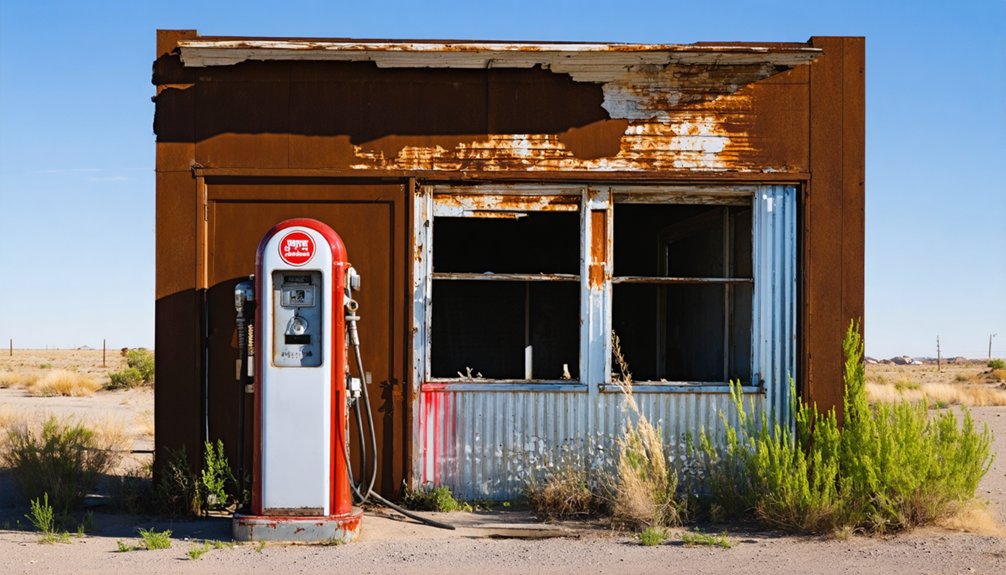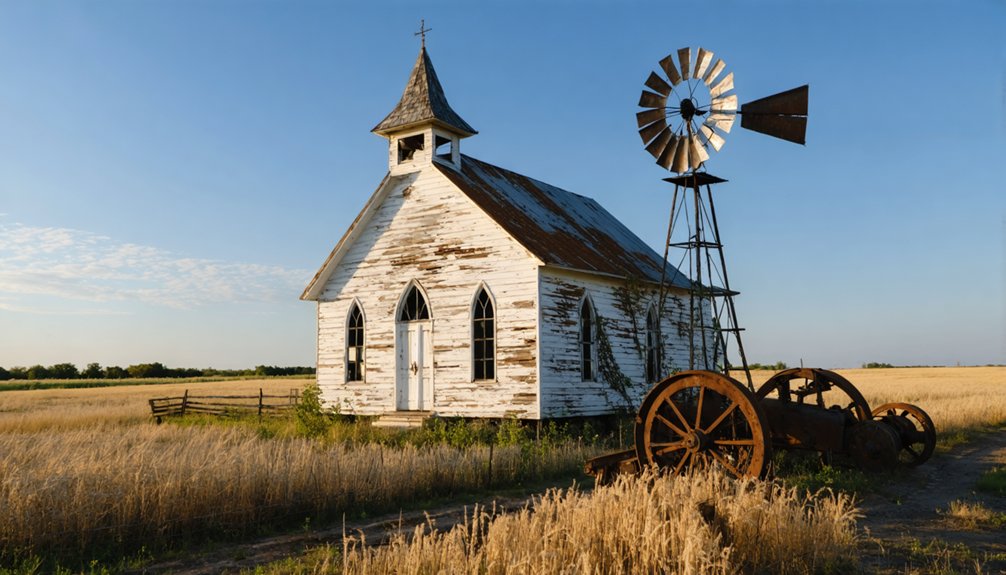You’ll find Juniper nestled in Texas’s Hill Country on the Edwards Plateau, where it once thrived as a late 19th-century ranching settlement. The ghost town features weathered adobe buildings, a Methodist church, and a historic cemetery that showcases its multicultural heritage. While accessing the remote site requires a high-clearance vehicle and careful navigation, you can still observe the architectural remnants that tell the story of this former community’s rise and mysterious decline.
Key Takeaways
- Juniper was established in the late 19th century as a ranching settlement in Texas’s Hill Country region on the Edwards Plateau.
- The town declined when younger residents moved to urban areas, becoming abandoned by the mid-20th century.
- Architectural remnants include weathered adobe buildings, a Methodist church, historic commercial structures, and a multicultural cemetery.
- The ghost town sits amid limestone hills with karst features, natural springs, and is dominated by Ashe juniper trees.
- Visitors must use high-clearance vehicles, respect private property boundaries, and follow desert safety protocols when exploring the ruins.
The Rise and Fall of a West Texas Settlement
While many Texas settlements flourished with the arrival of railroads and oil discoveries, Juniper’s story followed a different path.
You’ll find its origins in the late 19th century, when settlers were drawn to the area’s available land and water resources. The small community took root as a hub for local ranchers, featuring basic homes, a general store, and gathering spaces. Like Indian Gap, the town was situated along historic Native American travel routes. The town’s isolation was reinforced by barbed wire fences that controlled access to the settlement.
Without railroad connections or industrial development, Juniper struggled to achieve economic sustainability. You can trace its decline to limited transportation options and a dependency on small-scale ranching.
Isolated from vital rail networks and industrial growth, Juniper’s economy faltered, constrained by poor access and reliance on small ranching operations.
As younger residents sought opportunities in urban areas, rural depopulation took hold. By the mid-20th century, Juniper had succumbed to the fate of many isolated West Texas communities, transforming from a modest settlement into a ghost town.
Life in Early Juniper: A Ranching Community
As settlers established homesteads in Juniper during the mid-19th century, ranching emerged as the community’s economic backbone.
You’d find Anglo-Americans from Tennessee, Arkansas, and Missouri working alongside German immigrants from Hessian and Lower Saxony, all adapting their ranching practices to the region’s unique environment.
The community’s sustainability centered on the local Ashe Juniper woodlands and prairie grasslands.
You could see ranchers managing cattle, sheep, and goats while harvesting juniper wood for fence posts and railroad ties.
Cedar choppers carved out their niche in the local economy, while ranchers learned to balance grazing needs with the natural ecosystem.
The tight-knit community relied on shared knowledge and cooperation, with residents trading skills and resources to maintain their self-sufficient lifestyle in the Texas Hill Country.
The region experienced dramatic weather patterns, with precipitation varying from 11 to 41 inches annually in nearby areas.
Historical records from the 1840s documented mature Ashe Junipers throughout the settlement, confirming their native presence before European arrival.
Location and Geographic Features
Nestled within Texas’s rugged Hill Country region, Juniper sits at approximately 30°10′N latitude and 99°03′W longitude on the Edwards Plateau.
Perched in the heart of Texas Hill Country, Juniper claims its home amid the untamed expanse of the Edwards Plateau.
You’ll find impressive topographic diversity here, with limestone hills rising 400-500 feet above the surrounding plains. The terrain’s distinctive karst features include natural springs and caves, while the Edwards Aquifer flows beneath the rocky surface. Similar to Death Valley’s remote backcountry, the area offers numerous unexplored geological formations.
The area’s natural resources shaped early settlement patterns, with Ashe juniper and Texas live oak dominating the landscape alongside hardy desert plants like yucca and prickly pear cactus. The area features shallow clay loams that supported the region’s early ranching history.
While surface water remains limited, the springs that dot the region once sustained both wildlife and early ranching operations.
During spring, you’ll see vibrant wildflower displays punctuating the semi-arid scrubland, creating a striking contrast against the limestone outcrops.
Architectural Remnants and Historic Sites
Today’s visitors to Juniper encounter a collection of weathered adobe buildings that tell the story of this former mining settlement.
You’ll find long structures with tin roofs that once housed miners, alongside architectural styles reflecting the town’s diverse immigrant population, including skilled Polish brick masons who left their mark through distinctive masonry work.
The Methodist church stands as a symbol of the community’s religious life, with its damaged bell tower and preserved wooden pews inside.
The cemetery chronicles Juniper’s multicultural heritage through wrought-iron fencing and headstones honoring miners from Poland and Italy.
Historic commercial buildings, like adapted bank-pharmacy combinations and vintage gas stations, showcase the town’s economic evolution.
These preserved structures, along with commemorative markers from the 1930s, provide glimpses into Juniper’s vibrant past.
The tourist courts built in 1911 remain among the few surviving structures from the town’s early days.
Access to many original structures is restricted by no trespassing signs and protective fencing.
Local Legends and Historical Tales
Through the decades, mysterious tales and local folklore have shaped Juniper’s legacy as more than just another abandoned mining settlement.
You’ll find legendary anecdotes woven into the town’s history, from its enigmatic naming origins to accounts of Native American and settler interactions near Beaver Lake.
The town’s most enduring stories include:
- Spectral sightings near former business sites and abandoned homes
- Tales of sudden prosperity followed by swift economic decline
- Accounts of Comanche and Apache tribes using nearby rivers as gathering points
- Unexplained phenomena around old cemeteries and trading posts
Similar to Turlingua’s quicksilver mining boom, Juniper experienced a surge of economic activity that brought hundreds of families to the region.
While many of these stories lack formal documentation, they’ve been passed down through generations, reflecting the complex cultural tapestry of early Texas settlements and preserving the spirit of Juniper’s past. Like many Texas ghost towns such as Plemons, these tales often involve a safe river crossing that initially brought settlers and commerce to the area.
Exploring the Ghost Town Today
If you’re planning to explore Juniper’s remaining structures, you’ll need to carefully obtain permissions since the site spans multiple private properties with unclear ownership boundaries.
You should bring detailed maps or GPS coordinates to navigate the overgrown landscape, as there aren’t maintained paths or signage to guide your way.
Prepare for your visit by wearing sturdy boots, bringing plenty of water, and watching for unstable buildings and natural hazards that are common in abandoned Texas ghost towns.
Accessing Juniper’s Ruins
Reaching Juniper’s ruins requires careful navigation through remote West Texas desert terrain. You’ll need a high-clearance vehicle or 4WD to traverse the unpaved desert tracks that serve as access routes. The nearest settlement is Shafter, though you can’t enter through private property there.
When planning your visit to Juniper’s ruins, remember these essential guidelines:
- Stay outside marked private property boundaries and respect “No Trespassing” signs.
- Navigate using natural landmarks like the windmill and bubbling spring.
- Visit during daylight hours only due to rugged terrain and remoteness.
- Maintain distance from inhabited areas near Shafter to respect resident privacy.
Stick to photographing and observing from public access points, as interior exploration of structures isn’t permitted due to safety concerns and property restrictions.
Safe Desert Exploration Practices
When exploring the desert ruins of Juniper, proper preparation and safety measures are essential for survival in this remote West Texas environment.
You’ll need to carry double your estimated water supply and pack essential desert navigation tools including printed maps and a compass, as GPS signals are unreliable in this area. Always travel with at least one companion and inform others of your planned route.
Bring two spare tires, recovery gear, and extra fuel for your vehicle. When examining structures, stay alert for unstable ground, falling debris, and wildlife hazards. Don’t enter abandoned mines or climb deteriorating buildings.
Wear sturdy boots and sun protection while practicing “Leave No Trace” principles. Your survival skills should include basic first aid, heat exhaustion management, and vehicle recovery techniques for this challenging terrain.
Photography and Documentation Tips

Successfully capturing Juniper’s haunting essence requires careful photography preparation and technical expertise. Your photographic techniques should focus on documenting both the broad landscape and intimate details of this historic mining settlement, while storytelling methods must respect the site’s cultural significance.
- Pack essential gear: DSLR/mirrorless camera, varied lenses (wide-angle, macro, telephoto), sturdy tripod, and filters
- Time your shoots during golden hours for dramatic lighting, or explore nighttime photography for eerie atmospheres
- Compose shots that highlight characteristic elements: mining infrastructure, weathered buildings, and cemetery scenes
- Document thoroughly with detailed notes about locations, dates, and local histories, while comparing current conditions with historical records when possible
Remember to prioritize safety and preservation while capturing Juniper’s compelling story through your lens.
Frequently Asked Questions
Are There Any Dangerous Animals or Snakes to Watch Out For?
You’ll need wildlife awareness for venomous Western Diamondback and Mojave rattlesnake species, plus coral snakes. Watch for scorpions and black widow spiders in abandoned buildings and rocky areas.
What Is the Best Time of Year to Visit Juniper?
Time waits for no one, so plan your visit during spring (March-April) or fall (October-November). You’ll enjoy the best season’s mild weather conditions, perfect for hiking and exploring without extreme temperatures.
Is Camping Allowed Near the Ghost Town Site?
You can’t camp directly at the ghost town site, but you’ll find regulated camping at Juniper Point Campground nearby, which offers 44 sites with hookups and 25 basic sites.
Do You Need Special Permits or Permission to Visit?
Want to explore freely? You’ll need to check visitation regulations first. Since ownership status isn’t clear, it’s crucial to determine permission requirements before visiting to avoid trespassing on potentially private property.
Has Anyone Reported Paranormal Activity or Ghost Sightings?
You’ll find reports of ghostly encounters and spectral sightings similar to other Texas ghost towns, though they’re not well-documented. Local legends suggest shadowy figures and unexplained phenomena around abandoned structures.
References
- https://www.youtube.com/watch?v=FjezViMR1gw
- https://www.county.org/county-magazine-articles/summer-2025/ghost-towns
- https://mix941kmxj.com/the-strange-sad-story-of-a-texas-ghost-town-youll-never-visit/
- https://www.hipcamp.com/journal/camping/texas-ghost-towns/
- https://www.youtube.com/watch?v=phjUE19A8HM
- https://www.southernthing.com/ruins-in-texas-2640914879.html
- https://texashighways.com/travel-news/four-texas-ghost-towns/
- https://en.wikipedia.org/wiki/List_of_ghost_towns_in_Texas
- https://www.amysatticss.com/ghost-towns/
- https://www.wikiwand.com/en/articles/List_of_ghost_towns_in_Texas



